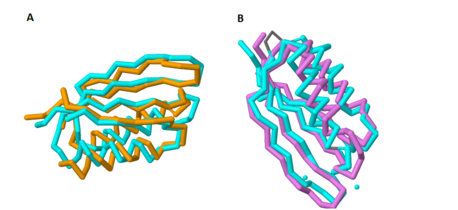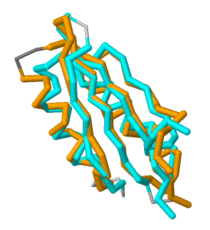Sandbox Reserved 1070
From Proteopedia
(Difference between revisions)
| Line 83: | Line 83: | ||
===Role in Dimerization=== | ===Role in Dimerization=== | ||
| - | The potential for [http://en.wikipedia.org/wiki/Protein_dimer dimerization] was another aspect of MgtC studied to see if this protein forms complexes with proteins of known function. A [http://subtiwiki.uni-goettingen.de/wiki/index.php/BACTH Bacterial Two-Hybrid (BACTH)] assay was performed to study the potential for the entire protein to dimerize with itself and the potential for individual domains to dimerize. The results of this assay showed that the entire MgtC protein likely dimerizes, but the individual domains do not. This dimerization could serve as a critical component to the biochemical function of MgtC, although the exact implications have not yet been discerned <ref name="mgtc"/>. Frantz ''et al''. proposed a role for MgtC to form dimers with [http://proteopedia.org/wiki/index.php/2mc7 MgtR] (PDB: [http://www.rcsb.org/pdb/explore/explore.do?structureId=2MC7 2MC7]), a protein that serves to promote the degradation of MgtC | + | The potential for [http://en.wikipedia.org/wiki/Protein_dimer dimerization] was another aspect of MgtC studied to see if this protein forms complexes with proteins of known function. A [http://subtiwiki.uni-goettingen.de/wiki/index.php/BACTH Bacterial Two-Hybrid (BACTH)] assay was performed to study the potential for the entire protein to dimerize with itself and the potential for individual domains to dimerize. The results of this assay showed that the entire MgtC protein likely dimerizes, but the individual domains do not. This dimerization could serve as a critical component to the biochemical function of MgtC, although the exact implications have not yet been discerned <ref name="mgtc"/>. Frantz ''et al''. proposed a role for MgtC to form dimers with [http://proteopedia.org/wiki/index.php/2mc7 MgtR] (PDB: [http://www.rcsb.org/pdb/explore/explore.do?structureId=2MC7 2MC7]), a protein that serves to promote the degradation of MgtC.<ref name="mgtr">Jean-Francois, F.L.; Dai, J.; Yu, L. ; Myrick, A. ; Rubin, E. ; ''et al''. Binding of mgtr, a salmonella transmembrane regulatory peptide, to mgtc, a mycobacterium tuberculosis virulence factor: a structural study. DOI:10.1016/j.jmb.2013.10.014</ref> This has huge implications in the overall clinical relevance of how MgtC could be targeted to develop new-generation antibiotics. |
==Clinical Relevance == | ==Clinical Relevance == | ||
| - | The development of an antibiotic which targets and inhibits MgtC could come from exploitation and enhancement of the process which promotes its degradation within ''Mycobacterium tuberculosis.'' MgtR, a hydrophobic peptide, promotes the degradation of MgtC upon high expression | + | The development of an antibiotic which targets and inhibits MgtC could come from exploitation and enhancement of the process which promotes its degradation within ''Mycobacterium tuberculosis.'' MgtR, a hydrophobic peptide, promotes the degradation of MgtC upon high expression within the bacteria.<ref name="mgtr"/> As previously stated, inadequate levels of MgtC within ''M. tuberculosis'' results in an inability to growth and survive. <ref name="mgtr"/> It is quite reasonable that analogues of MgtR could be developed, injected ([http://en.wikipedia.org/wiki/Subcutaneous_injection subcutaneously]) into infected patients, and resolve the tuberculosis infection by promoting degradation of MgtC and impairing growth of ''M. tuberculosis.'' |
==Future Work== | ==Future Work== | ||
Revision as of 12:35, 14 April 2015
| This Sandbox is Reserved from 02/09/2015, through 05/31/2016 for use in the course "CH462: Biochemistry 2" taught by Geoffrey C. Hoops at the Butler University. This reservation includes Sandbox Reserved 1051 through Sandbox Reserved 1080. |
To get started:
More help: Help:Editing |
MgtC: A Virulence Factor From Mycobacterium tuberculosis
| |||||||||||
References
- ↑ Singh, G.; Singh, G.; Jadeja, D.; Kaur, J. Lipid hydrolyzing enzymes in virulence: Mycobacterium tuberculosis as a model system. Critical Reviews in Microbiology 2010, 36(3): 259-269. DOI: doi: 10.3109/1040841X.2010.482923.
- ↑ 2.0 2.1 2.2 2.3 2.4 2.5 2.6 2.7 2.8 2.9 Yang, Y.; Labesse, G.; Carrere-Kremer, S.; Esteves, K.; Kremer, L.; Cohen-Gonsaud, M.; Blanc-Potard, A. The C-terminal domain of the virulence factor mgtc is a divergent act domain. J Bacteriol. 2012, 194(22): 6255-6263. DOI: 10.1128/JB.01424-12.
- ↑ 3.0 3.1 3.2 Jean-Francois, F.L.; Dai, J.; Yu, L. ; Myrick, A. ; Rubin, E. ; et al. Binding of mgtr, a salmonella transmembrane regulatory peptide, to mgtc, a mycobacterium tuberculosis virulence factor: a structural study. DOI:10.1016/j.jmb.2013.10.014


